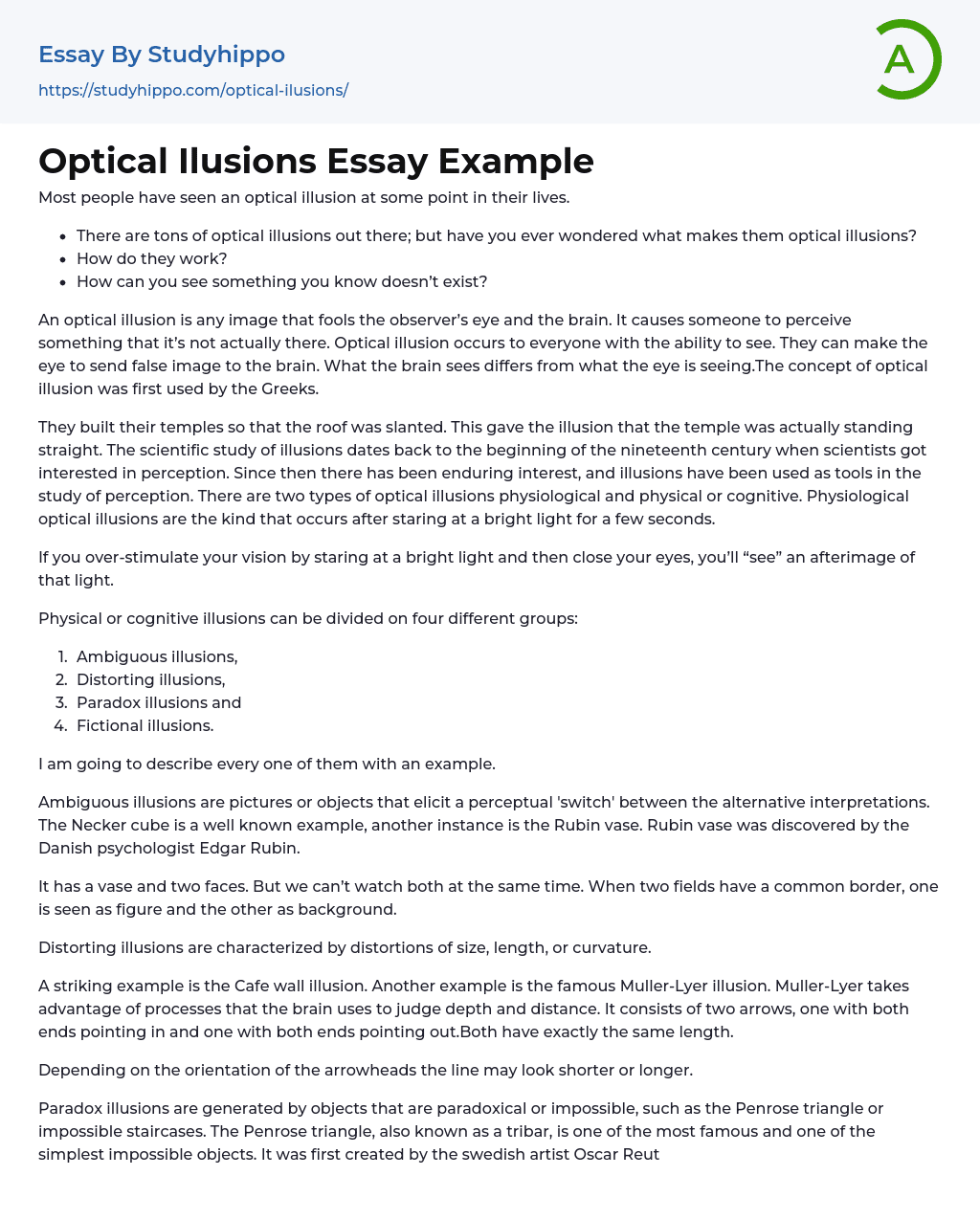Most people have seen an optical illusion at some point in their lives.
- There are tons of optical illusions out there; but have you ever wondered what makes them optical illusions?
- How do they work?
- How can you see something you know doesn’t exist?
An optical illusion is any image that fools the observer’s eye and the brain. It causes someone to perceive something that it’s not actually there. Optical illusion occurs to everyone with the ability to see. They can make the eye to send false image to the brain. What the brain sees differs from what the eye is seeing.The concept of optical illusion was first used by the Greeks.
They built their temples so that the roof was slanted. This gave the illusion that the temple was actually standing straight. The scientific study of illusions dates back to the beginning of the nineteenth century when scientis
...ts got interested in perception. Since then there has been enduring interest, and illusions have been used as tools in the study of perception. There are two types of optical illusions physiological and physical or cognitive. Physiological optical illusions are the kind that occurs after staring at a bright light for a few seconds.
If you over-stimulate your vision by staring at a bright light and then close your eyes, you’ll “see” an afterimage of that light.
Physical or cognitive illusions can be divided on four different groups:
- Ambiguous illusions,
- Distorting illusions,
- Paradox illusions and
- Fictional illusions.
I am going to describe every one of them with an example.
Ambiguous illusions are pictures or objects that elicit a perceptual 'switch' between the alternative interpretations. The Necker cube is a well known example
another instance is the Rubin vase. Rubin vase was discovered by the Danish psychologist Edgar Rubin.
It has a vase and two faces. But we can’t watch both at the same time. When two fields have a common border, one is seen as figure and the other as background.
Distorting illusions are characterized by distortions of size, length, or curvature.
A striking example is the Cafe wall illusion. Another example is the famous Muller-Lyer illusion. Muller-Lyer takes advantage of processes that the brain uses to judge depth and distance. It consists of two arrows, one with both ends pointing in and one with both ends pointing out.Both have exactly the same length.
Depending on the orientation of the arrowheads the line may look shorter or longer.
Paradox illusions are generated by objects that are paradoxical or impossible, such as the Penrose triangle or impossible staircases. The Penrose triangle, also known as a tribar, is one of the most famous and one of the simplest impossible objects. It was first created by the swedish artist Oscar Reutersvard. It is named after mathematician Roger Penrose, who popularised it in the 1950s. The tribar appears to be a solid object.
Fictional illusions are defined as the perception of objects that are genuinely not there to all but a single observer. These are more properly called hallucinations. The scope of optical illusion is not limited to the artificial ones. In fact artificial illusions they were inspired from the natural ones.
Different animals use their camouflaging abilities to hide from their predators or when they are on hunt. Here is an image of stick insect camouflaging itself. Some butterflies also have dots on their wings that resemble
eyes. Hence successfully scaring away their predictorsMirage is another example of natural optical illusion.
This phenomenon is caused by rays of light refracted in layers of air having different densities. This refraction causes an imaginary pond of water to appear on surface. This photo shows the floor tiles at the Basilica of St. John Lateran, located in Rome.
The pattern is actually two dimensional, but it appears to be three dimensional. Optical illusions are very useful and they can affect our daily lives too. They are used in different exams to gauge the intelligence, psychology and interpretation skills of a person. Camouflaging abilities of animals are also replicated to hide soldiers, tanks, ships, nuclear reactors and other defense related installations.
Artists such as MC Escher and other have long used illusion in art, creating images that are visually intriguing as well as artistic, stimulating both the mind and the eye. Other artists who have produced optical illusion masterpieces include Dali, Raphael, and Seurat, among many others. Architects use optical illusion in buildings to create the illusion of depth and space. Magicians use it in tricks for our amusement.
- Incandescent Light Bulb essays
- John Locke essays
- 9/11 essays
- A Good Teacher essays
- A Healthy Diet essays
- A Modest Proposal essays
- A&P essays
- Academic Achievement essays
- Achievement essays
- Achieving goals essays
- Admission essays
- Advantages And Disadvantages Of Internet essays
- Alcoholic drinks essays
- Ammonia essays
- Analytical essays
- Ancient Olympic Games essays
- APA essays
- Arabian Peninsula essays
- Argument essays
- Argumentative essays
- Art essays
- Atlantic Ocean essays
- Auto-ethnography essays
- Autobiography essays
- Ballad essays
- Batman essays
- Binge Eating essays
- Black Power Movement essays
- Blogger essays
- Body Mass Index essays
- Book I Want a Wife essays
- Boycott essays
- Breastfeeding essays
- Bulimia Nervosa essays
- Business essays
- Business Process essays
- Canterbury essays
- Carbonate essays
- Catalina de Erauso essays
- Cause and Effect essays
- Cesar Chavez essays
- Character Analysis essays
- Chemical Compound essays
- Chemical Element essays
- Chemical Substance essays
- Cherokee essays
- Cherry essays
- Childhood Obesity essays
- Chlorine essays
- Classification essays




